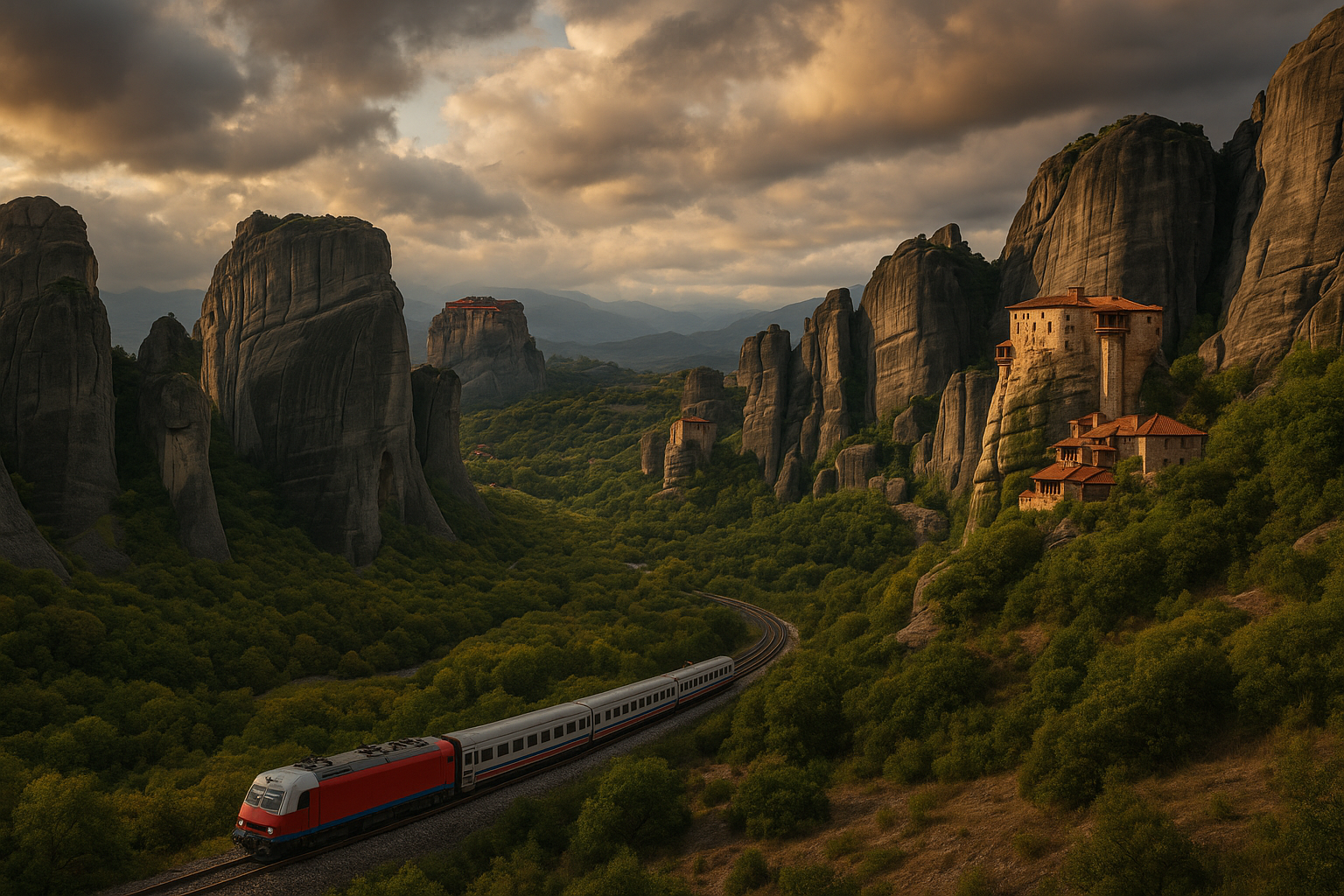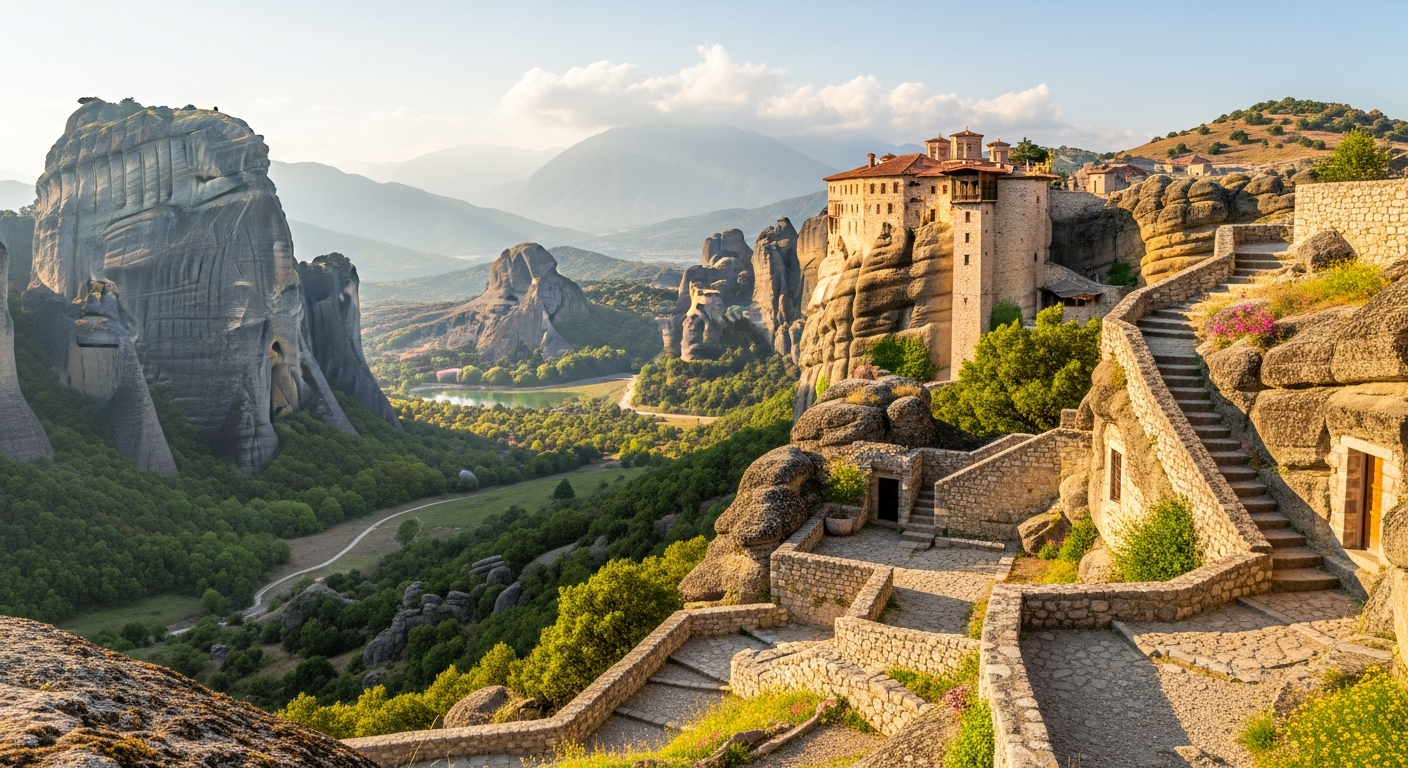Imagine giant pillars of rock reaching for the sky. Now, picture ancient monasteries perched precariously on their peaks. This is not a fantasy scene; it is the breathtaking reality of Meteora, Greece. These sandstone formations, sculpted by time and weather, create a truly otherworldly landscape. For centuries, monks sought refuge and spiritual solitude here. Today, six of these incredible structures remain active and welcome visitors. Travel Guide
This guide provides everything you need to plan your unforgettable trip. We will explore how to get there, where to stay, and what to expect at each monastery. Consequently, you can experience the magic of this UNESCO World Heritage site with confidence. Meteora Monasteries Travel Gui…
Getting to Meteora
Reaching this stunning destination is part of the adventure. You have several great options from Greece’s main cities. The choice often depends on your budget, schedule, and travel style.
From Athens
Traveling from Athens is straightforward. Many people choose the train for its comfort and scenic views. The direct train departs from Athens’ Larissa Station and arrives in Kalabaka, the town at the foot of Meteora. This journey typically takes around four to five hours. Alternatively, you can take a KTEL bus. The bus ride is slightly longer but can be a more budget-friendly option. Driving a rental car offers the most flexibility. The trip by car takes about four hours and allows you to explore the surrounding area at your own pace.

From Thessaloniki
If you are coming from northern Greece, Thessaloniki is your starting point. The train journey from Thessaloniki to Kalabaka is also a popular choice. However, it often requires a change at Paleofarsalos station. The total travel time is approximately three hours. Buses run directly from Thessaloniki to Kalabaka, providing a simple and cost-effective alternative. Furthermore, driving from Thessaloniki is another excellent option. The drive is less than three hours and gives you complete control over your itinerary.
Where to Stay: Kalabaka vs. Kastraki
Choosing your home base is a key part of the Meteora Monasteries: Complete Visitor Gu… experience. The two primary villages, Kalabaka and Kastraki, each offer a unique atmosphere.
Meteora Monasteries Travel Guide – Lonel… is the larger of the two towns. Here, you will find a wider selection of hotels, restaurants, and shops. It serves as the region’s main transportation hub, making it very convenient for arrivals and departures. Because of its size, Kalabaka has a more bustling feel.
On the other hand, Kastraki is a smaller, more traditional village. It sits nestled directly among the giant rock pillars, offering more dramatic and immediate views. Kastraki provides a quieter, more tranquil experience. While it has fewer amenities than Kalabaka, its charm and proximity to the Monasteries make it a favorite for many visitors. Ultimately, your choice depends on whether you prefer convenience and options or peace and atmosphere.

. Meteora Monasteries: A Complet…
Exploring the Six Monasteries
Six monasteries remain active and are open to the public. Each has its own unique history, architecture, and character. Remember that opening hours can vary by season, so always check the latest schedules before you go.
The Great Meteoron Monastery
As its name suggests, this is the largest, oldest, and highest of the Meteora Monasteries – UNESCO World Herit…. Saint Athanasios the Meteorite founded it in the 14th century. Inside, you can explore a fascinating museum, a beautiful main church (katholikon), and an old kitchen. The views from its courtyard are simply spectacular. However, be prepared for a climb, as many steps lead up to the entrance.
The Varlaam Monastery
Varlaam is the second-largest monastery and is known for its impressive frescoes and a museum showcasing religious artifacts. It offers a wonderful glimpse into the monastic life and history of the region. Visitors can also see the old rope basket system that monks once used to hoist up people and supplies. The access is easier than the Great Meteoron, but it still requires a walk up a series of carved steps. Travel Guide
The Roussanou Monastery
Now a convent, Roussanou sits on a lower rock pillar. This makes it one of the most photographed monasteries in Meteora. Its position offers stunning panoramic views of the valley and surrounding rock formations. Access is relatively easy via a couple of small bridges from an adjacent plateau. The interior frescoes are remarkably well-preserved and depict powerful religious scenes. Meteora Monasteries: Complete …
St. Nicholas Anapausas Monastery
This monastery is compact and built vertically to fit its narrow rock perch. It is often the first monastery visitors encounter when coming from Kastraki. St. Nicholas is celebrated for its exquisite 16th-century frescoes, painted by the renowned Cretan artist Theophanis Strelitzas. Due to its small size, it can feel crowded, but the artwork inside makes the visit worthwhile. Meteora Monasteries Official T…
St. Stephen’s Monastery
St. Stephen’s is the most accessible monastery. A small stone bridge connects it directly to the main road, eliminating the need to climb any stairs. This makes it an ideal choice for visitors with mobility challenges. Now operating as a convent, it houses two churches and a small museum. The nuns are known for their hospitality and maintain beautiful gardens on the monastery grounds.
The Holy Trinity Monastery
For many, the Holy Trinity Monastery is the most visually dramatic. It sits atop a slender, precipitous rock and gained international fame after appearing in the James Bond film For Your Eyes Only. Reaching it requires a significant effort. You must first descend into a ravine and then climb approximately 140 steep steps. Consequently, it is one of the least visited monasteries, offering a more serene and rewarding experience for those who make the trek.
Essential Tips for Your Visit
To make the most of your trip, keep a few practical details in mind. Proper planning ensures a smooth and respectful visit to these sacred sites.
Dress Code
A strict dress code is enforced at all monasteries. Men must wear long trousers. Women must wear long skirts and cover their shoulders. Shorts and sleeveless tops are not permitted for anyone. If you are not dressed appropriately, you will be denied entry. However, most monasteries offer wrap-around skirts and shawls at the entrance for visitors to borrow.
Entrance Fees and Opening Hours
Each monastery charges a small entrance fee, typically around 3 euros per person. This fee helps with the maintenance and preservation of these historic sites. It is crucial to check the opening hours before your visit. Meteora Monasteries Official Visitor Gui… operate on a rotating schedule, meaning at least one is closed to the public each day of the week. Schedules also change between the summer and winter seasons. The official tourism websites provide the most current information.
Getting Around Meteora
You can explore the area in several ways. Renting a scooter or car provides the most freedom. A local bus service runs between Kalabaka, Kastraki, and the Meteora Monasteries: A Complete Visitor’… several times a day. For a more active experience, you can hike along ancient footpaths that connect the monasteries. These trails offer incredible views away from the main roads. Additionally, guided tours are widely available. These tours often include transportation and provide valuable historical context from a local expert.
Historians confirm that monks began building these monasteries in the 14th century to escape political turmoil and find spiritual isolation . Source

